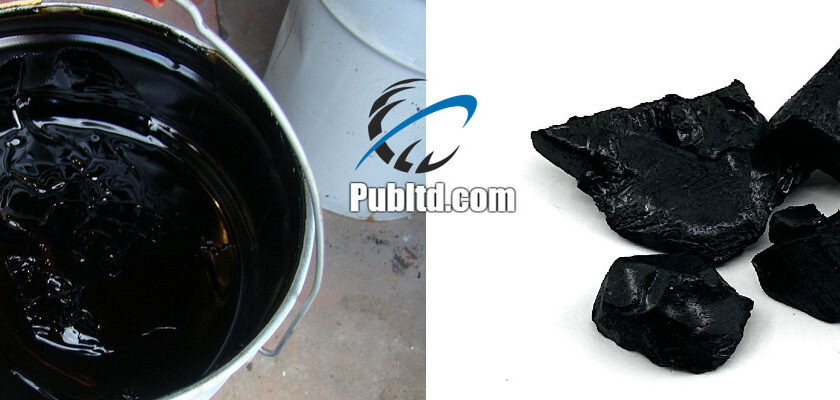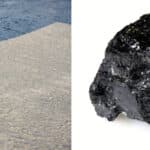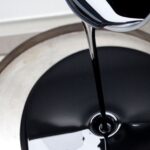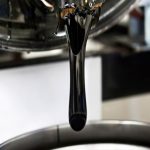
Oxidized Bitumen vs Penetration Bitumen: Uses and Applications
In industrial and civil engineering projects, bitumen is a critical material. Two of the most commonly used types are oxidized bitumen (also known as blown bitumen) and penetration grade bitumen. Each serves distinct purposes based on its chemical properties and production method. Bitumen is a crucial material in the construction industry, serving as a binding agent in asphalt for roads, waterproofing for roofs, and more. Two common types of bitumen used in various applications are Oxidized Bitumen and Penetration Bitumen.
In this blog, we will delve into the characteristics, uses, and applications of both Oxidized and Penetration Bitumen, highlighting how Peak Universal Business serves as a trusted supplier for these essential materials.
🔥 What Is Oxidized Bitumen?
Oxidized bitumen is produced by blowing air through penetration bitumen at high temperatures (240°C–300°C). This modifies its structure, increasing its softening point and decreasing penetration—making it more rigid and resistant to flow under heat.
🧪 Common Grades
-
85/25
-
90/40
-
115/15
Used in roofing, waterproofing, sealants, and industrial insulation.
Oxidized bitumen Uses & Applications
Waterproofing:
Due to its high softening point and resistance to temperature fluctuations, Oxidized Bitumen is extensively used for waterproofing applications. It forms a robust barrier against moisture, preventing water ingress and protecting structures from water damage.
Roofing:
Oxidized Bitumen is commonly used as a roofing material, either as a standalone product or in combination with other materials like fiberglass or polyester. It provides excellent waterproofing properties and can withstand harsh weather conditions, making it a popular choice for both residential and commercial roofing projects.
Pavement Sealing:
In road construction and maintenance, Oxidized Bitumen is used for pavement sealing to enhance the lifespan of the roads. It acts as a sealant, filling in cracks and preventing water and debris from penetrating the pavement, thereby reducing the need for frequent repairs and maintenance.
🔬 What Is Penetration Grade Bitumen?
Penetration bitumen is a type of viscous, semi-solid material directly derived from crude oil refining. It is classified based on its penetration value, which measures how far a standard needle penetrates the bitumen at a certain temperature.
⚙️ Common Grades
-
40/50
-
60/70
-
80/100
These grades are mostly used in road paving and hot-mix asphalt production.
Characteristics
Penetration Bitumen is a bitumen grade that is characterized by its penetration value, which is a measure of its hardness and consistency. It is produced by distilling crude oil and refining the residue to obtain a material with specific penetration and softening point properties. Penetration Bitumen is classified into different grades based on its penetration value, with higher penetration values indicating softer bitumen and lower values indicating harder bitumen.
Penetration bitumen Uses & Applications
Road Construction:
Penetration Bitumen is the most commonly used bitumen grade in road construction due to its excellent binding properties and ability to withstand heavy traffic loads. It is used as a binder in asphalt mixes to create durable and resilient road surfaces that can withstand the rigors of daily traffic and adverse weather conditions.
Pavement Maintenance:
In addition to its use in new road construction, Penetration Bitumen is also used for pavement maintenance and repair. It is applied as a binder in patching mixes to fill in potholes, cracks, and other surface defects, restoring the structural integrity and smoothness of the pavement.
Waterproofing:
Like Oxidized Bitumen, Penetration Bitumen is also used for waterproofing applications, particularly in below-ground structures like basements, tunnels, and foundations. It forms a waterproof barrier that protects these structures from groundwater ingress and moisture-related damage.
📊 Comparison Table: Oxidized vs Penetration Bitumen
| Feature | Penetration Bitumen | Oxidized Bitumen |
|---|---|---|
| Production | From vacuum residue | Air-blown from penetration bitumen |
| Softening Point | Lower (40–60°C) | Higher (85–150°C) |
| Penetration Value | High (more flow) | Low (rigid) |
| Thermal Stability | Moderate | Excellent |
| Water Resistance | Moderate | Excellent |
| Elasticity | More elastic | Less elastic, more rigid |
| Applications | Road paving, asphalt | Roofing, waterproofing, coatings |
| Appearance | Shiny black, smooth | Matte, dense, firm |
Peak Universal Business: Your Trusted Supplier
When it comes to sourcing high-quality Oxidized and Penetration Bitumen for your construction projects, Peak Universal Business is the supplier you can trust. With years of experience in the bitumen industry, Peak Universal Business offers a comprehensive range of bitumen products that meet international quality standards and specifications.
Why Choose Peak Universal Business?
Quality Assurance:
All our bitumen products undergo stringent quality control checks to ensure consistency, performance, and durability. We take pride in delivering products that exceed our customers’ expectations and stand the test of time.
Customized Solutions:
At Peak Universal Business, we understand that every project has unique requirements. That’s why we offer customized bitumen solutions tailored to meet your specific needs and application requirements.
Expert Advice & Support:
Our team of bitumen experts is always on hand to provide expert advice and support to help you make informed decisions and ensure the success of your construction projects.
❓ FAQ: Oxidized vs Penetration Bitumen
Which is better: oxidized or penetration bitumen?
It depends on the use. Oxidized bitumen is better for waterproofing and insulation, while penetration bitumen is ideal for road construction due to its flexibility.
Can oxidized bitumen be used for roads?
No. Oxidized bitumen is too rigid and brittle for road applications, where elasticity is required.
What are the main grades of each type?
-
Penetration: 60/70, 80/100
-
Oxidized: 90/10, 115/15, 85/25
Is oxidized bitumen more durable?
Yes, in terms of thermal and chemical resistance, oxidized bitumen performs better in industrial environments.
What is the main chemical difference between oxidized and penetration bitumen?
Oxidized bitumen undergoes air-blowing at high temperatures, introducing oxygen into the structure, which increases its asphaltene content and creates a more complex molecular network. In contrast, penetration bitumen remains relatively unmodified and is derived directly from the distillation of crude oil.
Why is oxidized bitumen not suitable for hot-mix asphalt?
Oxidized bitumen becomes brittle at low temperatures and lacks the elasticity required to withstand road surface stress and temperature fluctuations. It may crack under vehicle loads, making it unsuitable for paving applications.
Can penetration grade bitumen be converted into oxidized bitumen?
Yes. Oxidized bitumen is produced by air-blowing penetration bitumen in reactors at controlled temperatures, changing its physical and chemical properties.
Which bitumen is more resistant to weathering and aging?
Oxidized bitumen is generally more resistant to oxidative aging, UV exposure, and chemical attack, making it ideal for long-term industrial uses like roofing and insulation.
Is oxidized bitumen more environmentally friendly than penetration bitumen?
Not necessarily. Both have environmental impacts if not handled properly. However, oxidized bitumen, due to its longer service life in some applications, may reduce replacement frequency, thereby lowering lifecycle emissions in specific contexts.
What are the ideal storage conditions for oxidized bitumen?
Oxidized bitumen should be stored in dry, cool environments, away from direct sunlight and moisture. It is typically stored in drums or blocks, depending on the form (solid or semi-solid).
How do costs compare between oxidized and penetration bitumen?
Oxidized bitumen is typically more expensive due to additional processing (air-blowing) and its use in specialized applications. Penetration bitumen is more economical for bulk road paving projects.
Which standards govern the quality of oxidized and penetration bitumen?
-
Penetration Bitumen: ASTM D946, EN 12591
-
Oxidized Bitumen: ASTM D36 (softening point), ASTM D5 (penetration), ASTM D6 (loss on heating)
✅Conclusion-Oxidized Bitumen vs Penetration Bitumen
Both oxidized and penetration bitumen are indispensable in their respective domains. Understanding their differences in structure, properties, and applications ensures the right material is chosen for the job—whether it’s flexibility for paving or rigidity for waterproofing. Whether you need Oxidized Bitumen for waterproofing and roofing applications or Penetration Bitumen for road construction and pavement maintenance, Peak Universal Business has got you covered.
With our commitment to quality, innovation, and customer satisfaction, Peak Universal Business is your trusted partner for all your bitumen needs. Contact us today to learn more about our products and services or to request a quote for your next construction project.
You can Read More about Bitumen Here:
Bitumen Emulsion vs Cutback Bitumen: Its Uses & Applications
Penetration Bitumen 80/100 Uses & Its Advantages
What is Oxidized Bitumen 75/25 and its Industrial Applications?
📣 Call to Peak Universal Business
🔍 Are you sourcing the right bitumen for your project?
We in Peak Universal Business, supply & provide high-purity, industry-grade Bitumen customized to your specifications, with global delivery and competitive pricing.
👉 Contact our technical team for grade selection, bulk pricing, and application guidance.
🔹 Request a Quote | 🔹 Download TDS | 🔹 Talk to a Bitumen Specialist
📧 Email: [email protected]
📞 Phone: +971 4 878 2031
🌐 Visit: PUBLtd.Asphalts
If You have any other Query or Question you want to ask, Please don’t hesitate to Contact Us.
- 0 comment





Leave a Reply